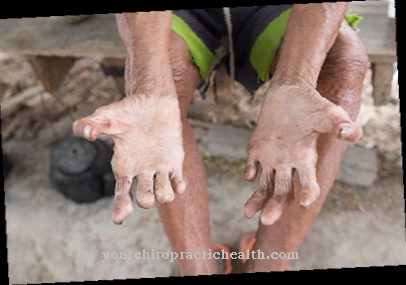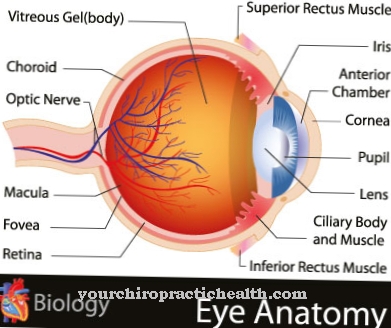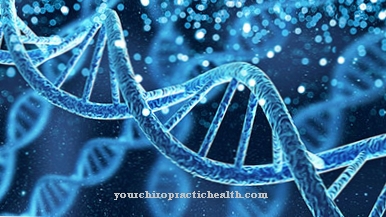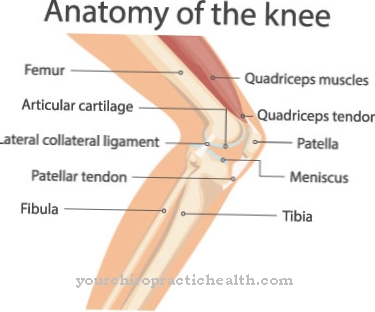The Microcephaly belongs to the rarer malformations in humans. It is either genetically determined or acquired and primarily manifests itself in a skull that is too small. Children born with microcephaly also often have smaller brains and other physical and mental developmental disorders. However, there are also cases of microcephaly in which the young patients develop cognitively normally despite their smaller brain size.
What is microcephaly?

© 7activestudio - stock.adobe.com
Under Microcephaly (MCPH) one understands a malformation of the human skull: it is too small in relation to that of other people of the same sex and age. Microcephaly is usually not that noticeable at birth. The developmental disorder becomes clearly visible later when the head circumference does not "grow". It can then be more than 30 percent less than for other people of the same age.
Microcephaly is most often associated with cognitive disabilities and other limitations. As a rule, the children also have a brain that is too small for their age. The intellectual deficit is low to moderate. Microcephaly occurs in the ratio 1.6: 1000. Primary microcephaly is usually inherited as an autosomal recessive trait. The secondary form arises, for example, from infections and brain injuries to which the embryo is exposed in the womb.
causes
Microcephaly can have many causes. The main cause is dyscephaly: the child's brain grows too slowly in the womb due to insufficient pressure. Therefore, the skull cannot expand to the normal extent. As Australian scientists found out in 2012, a gene called TUBB5 is responsible for impaired brain growth. TUBB5 produces a protein called tubulin, which is important for cell structure.
If TUBB5 mutates, the embryo's brain continues to grow much more slowly. If there is a craniostenosis, the cranial sutures close prematurely, so that the brain can no longer grow. If the craniosis is recognized in good time, they can be surgically separated. Other causes are gene mutations: MICPCH syndrome (a form of microcephaly) occurs when the CASK gene located on the X chromosomes mutates. Infections of the expectant mother with rubella, the cytomegalovirus, chickenpox or toxoplasmosis can also lead to microcephaly.
In addition, alcohol or drug abuse by the pregnant woman can have such adverse effects on the child. The same applies if she is exposed to radiation (cancer treatment). Untreated phenylketonuria (PKU) and cerebral anoxia (the brain does not receive enough oxygen) can also cause the developmental disorder in the unborn child.
Symptoms, ailments & signs
The clearest sign of microcephaly is that the head circumference is too small in relation to children of the same age. The bridge and the cerebellum have lagged behind in their development. In addition, cognitive and motor retardation can be observed. Language development is delayed. As a result of swallowing disorders, they have difficulty ingesting food and are therefore often up to 30 percent underweight and also too small.
Some of them have problems with their balance. Many children with microcephaly are hyperactive and show involuntary movements (hyperkinesia). Around ten percent of them have epileptic seizures. Because of their lower immune system, they have an increased tendency to infectious diseases, which can have a negative impact on their life expectancy. Characteristic of microcephaly patients with hypotension (insufficient muscle tension) is their curved back. They also have a four-finger furrow on the palm of their hand, a sandal gap, and twin teeth.
Diagnosis & course of disease
Whether a fetus has microcephaly can only be determined from the 32nd week of pregnancy using prenatal ultrasound. Usually, however, the developmental disorder is not recognized until much later. The specialist measures his head circumference and compares it using head-circumference tables. It is also possible to carry out X-rays, CT scans and MRIs.
The CT scan is preferable to the X-ray image because of its greater accuracy.The characteristics that cause the mutation of the CASK gene can be clearly seen on an MRI image: A slightly smaller brain that looks essentially normal and only differs in terms of a somewhat simplified brain-convolutions pattern. However, parents can only be absolutely certain after a blood and urine test.
Complications
Microcephaly primarily leads to impaired mental and motor development in those affected. Especially for children there are severe complaints, so that they are usually dependent on the help of other people at a later age. Speech disorders and swallowing difficulties also occur, so that those affected cannot ingest food alone.
Balance disorders or epileptic seizures also occur. It is not uncommon for those affected to suffer from reduced muscle tension and various malformations on the body. The parents or relatives can also suffer psychologically due to the illness or be affected by depression. The affected children are not infrequently hyperactive and thus cannot follow the lessons.
As a rule, they therefore need special instruction. With the help of various therapies, the symptoms of microcephaly can be limited. A complete cure of this disease is not possible, however, so that the patients usually depend on the help of other people for their entire life. Cramps can be limited with the help of medication. There are no particular complications in the treatment of this disease.
When should you go to the doctor?
Microcephaly is usually not recognized immediately. The affected children initially appear healthy. Within the first months of life, however, it becomes very clear that the head circumference is smaller than that of their peers. Unless the treating pediatrician makes the diagnosis by himself as part of routine examinations, parents should definitely consult a doctor if they suspect microcephaly. The disease should be treated as early as possible.
The sooner the affected child receives suitable therapy, the better the chances of a longer life expectancy. It is important to start physiotherapy, occupational therapy and speech therapy as early as possible, as the child can achieve a certain degree of independence through intensive support and the parents can thus be relieved. In the case of repeated seizures in particular, the pediatrician or a specialist should be consulted. In such cases, rapid drug treatment is required.
Therapy & Treatment
There is no complete cure for people with microcephaly. However, with the help of suitable therapies, parents can increase the life expectancy of their child and give him more joy in life. The earlier the child receives the appropriate treatment, the greater their chances are later. The head circumference can no longer be corrected, but parents can ensure that their child regularly takes part in physiotherapy as well as occupational and speech therapy.
It is also important to promote the disabled child's independence and to strengthen his or her self-confidence. Regular checks of head circumference and general growth help to be able to intervene more quickly in case of difficulties. Symptoms such as hyperactivity and seizures can easily be treated with medication.
Outlook & forecast
Basic information on the outcome of a microcephaly is difficult. In any case, those affected have to adjust to lifelong restrictions. How strong these are varies from case to case. In practice, it is often difficult that the disease has not been researched enough. This means that important knowledge that is crucial for therapy is missing. Since statistically only 1.6 out of 1,000 children develop microcephaly and these are mainly located in Africa, only a slow improvement in treatment options can be expected.
The malformation of the skull is diagnosed in young children. To what extent physical development can contribute to an improvement cannot be predicted. In any case, doctors cannot correct the reduced head circumference. Nevertheless, parents should not do without the help offered. Non-treatment is the worst option, because at least the consequences and side effects can be treated. Physiotherapy and speech therapy can help improve the situation. Many sick people have a mental or physical handicap. As a result, they are dependent on aids for a lifetime. Overall life expectancy does not have to be restricted due to microcephaly.
prevention
Parents who have a microcephaly child and would like to have more children should definitely try to find out what causes the microcephaly. If it is genetic, the only thing that helps is to see a specialist who can tell you the likelihood of the further offspring also getting the developmental disorder. With autosomal recessive inheritance, there is a 25 percent chance that the child will also have a smaller skull.
Aftercare
Since microcephaly generally cannot be completely cured, follow-up care focuses on managing the disease well. Sufferers should try to build a positive outlook on life despite the adversity. Relaxation exercises and meditation can help.
The affected person can only speak very slowly, so that there is also disruption and a significant delay in the child's development. As a rule, those affected also suffer from significant retardation and also from disturbances in balance, so that there are restrictions and disturbances in everyday life. Various malformations or deformities can also occur on the body of the person affected and thus also significantly reduce the aesthetics. In addition to therapeutic measures, it is helpful to sensitize the social environment to the disease in order to prevent misunderstandings.
Since the symptoms of microcephaly are sometimes severe, this can also lead to depression or other severe psychological disorders in the parents or relatives. It is advisable to clarify this with an experienced psychologist and to weigh up the extent to which therapy is appropriate. Contact with people who are equally ill can also help improve the quality of life.
You can do that yourself
Microcephaly manifests itself in childhood and is often, if not always, associated with impaired cognitive abilities. Parents who suspect their child may have microcephaly should seek medical advice immediately. If the suspicion is confirmed, in addition to the diagnosis, a thorough investigation of the causes is urgently required. The latter is particularly important with regard to family planning. Microcephaly can be genetic. If this is the case, those affected whose family planning has not yet been completed should seek genetic counseling.
Which auxiliary measures are indicated for the patients themselves depends on the degree of the disability. A learning disability can usually not be completely compensated for by early pedagogical and psychotherapeutic care, but it can almost always be mitigated. Occupational and physiotherapeutic measures can help counteract the consequences of delayed or impaired motor development. In the case of speech disorders, a speech therapist should be consulted at an early stage.
This can be very stressful for the parents. You should therefore seek professional support in caring for your child. It is important to apply for a care level early on. Since children who suffer from microcephaly often cannot attend a normal primary school and places at special schools are scarce, parents should start school much earlier than with a healthy child.

.jpg)











.jpg)

.jpg)
.jpg)











.jpg)